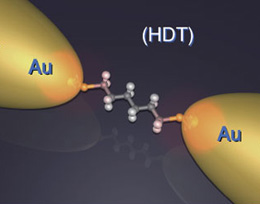Research Abstract
電流ノイズによる1分子識別
本論文では、量子ゆらぎで生じた1有機分子の非弾性ノイズの直接観測による分子識別について報告する。
Single-molecule identification via electric current noise
2010年12月14日 Nature Communications 1 : 138 doi: 10.1038/ncomms1141

非標識実時間1分子検出によって、スループットの高いバイオセンシングプラットフォームの開発が促進されるかもしれない。分子のゆらぎはノイズ源であり、 1分子の性質の詳細情報を不明瞭にして1分子識別を妨げることが多い。本論文では、量子ゆらぎで生じた1有機分子の非弾性ノイズの直接観測による分子識別 について報告する。我々は、2つの電極に化学的に結合した1分子を通って流れる電流のゆらぎを調べた。その結果、非弾性電子トンネリングに寄与する分子の 固有振動モードの電場励起に同期して、電流振動が増加することがわかった。この発見は、1分子接合のノイズ特性に対して電荷と原子の運動との相互作用の寄 与が大きいことを示しており、1分子識別に役立つ分子指紋として非弾性ノイズを利用できる可能性があることを示唆している。
- 大阪大学 産業科学研究所
- 科学技術振興機構 さきがけ
Label-free and real-time single-molecule detection may aid the development of high-throughput biosensing platforms. Molecular fluctuations are a source of noise that often hinders single-molecule identification by obscuring the fine details of molecular identity. In this study, we report molecular identification through direct observation of quantum-fluctuation-induced inelastic noise in single organic molecules. We investigated current fluctuations flowing through a single molecule that is chemically connected to two electrodes. We found increased current oscillations synchronous to electric field excitations of characteristic molecular vibrational modes that contribute to inelastic electron tunnelling. This finding demonstrates a large contribution of charge interaction with nuclear dynamics on noise properties of single-molecule bridges and suggests a potential use of inelastic noise as a valuable molecular signature for single-molecule identification.

